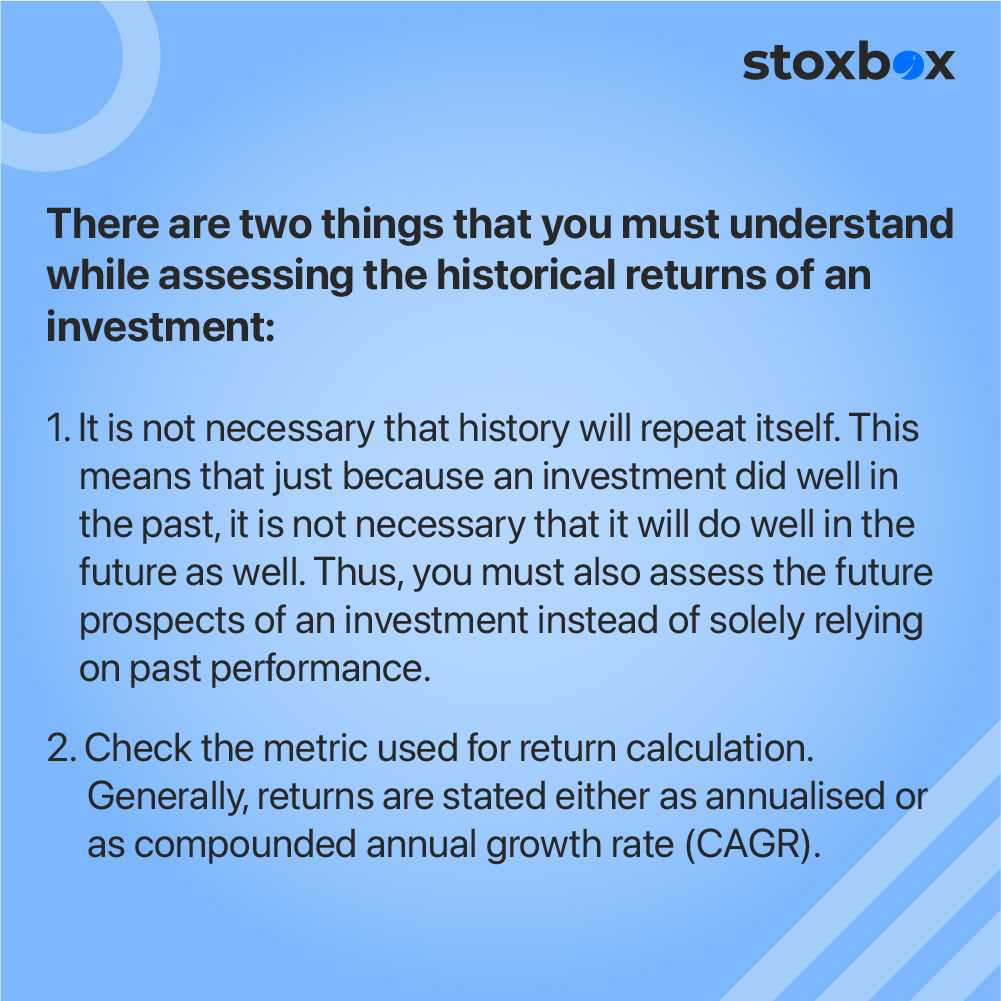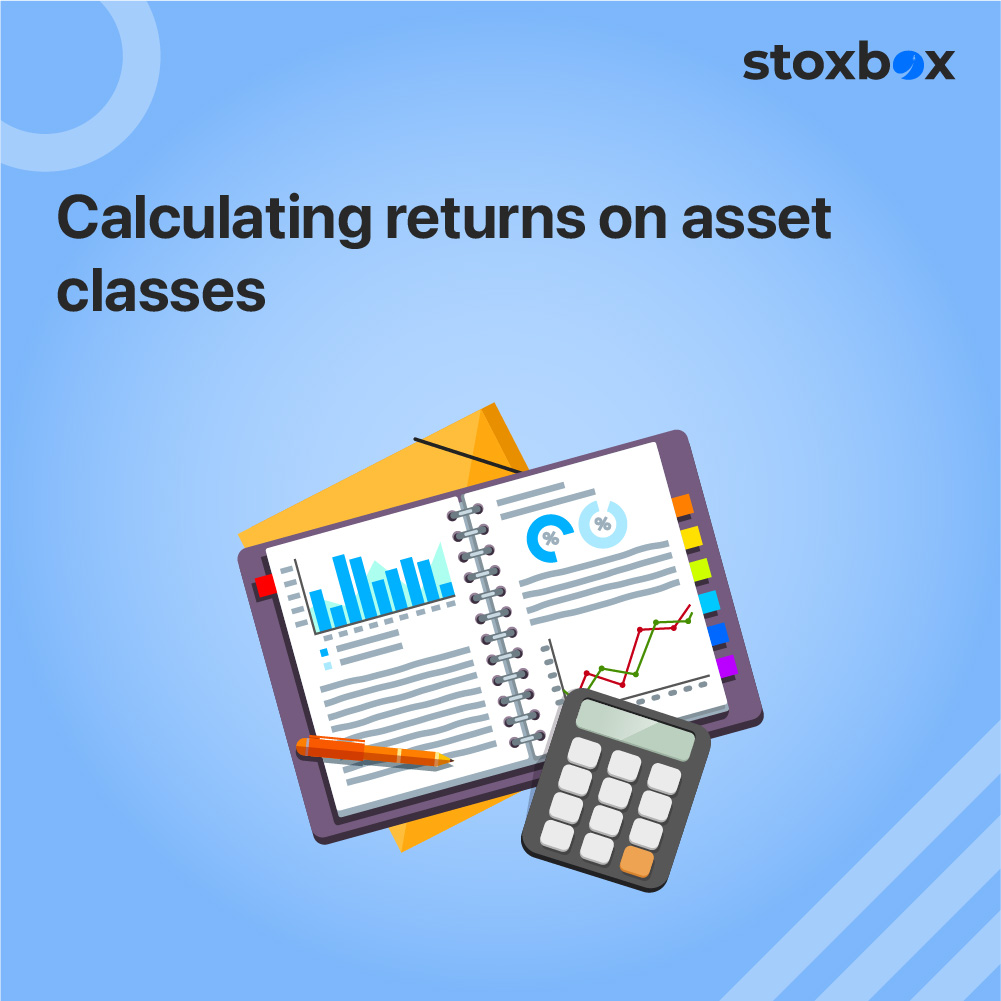Understand how much return are you getting from your investment
Table of Contents
When you invest your money, you want to know how well it’s growing over time. That’s where the average rate of return comes in. It’s a simple way to measure how much profit your investments are making on average over a specific period.
For instance, whether you’re tracking your portfolio performance or comparing investment options, understanding the rate of return on investment gives you a clear picture of how well your money is working for you. Think of it as a snapshot of your financial growth, helping you make better decisions about where to invest next.
Simple Ways to Calculate Returns
Understanding how to calculate the rate of return on investment is essential for evaluating your portfolio. Let’s break it down step by step so it’s easy to follow. These methods will help you assess your returns and make informed financial decisions.
Basic Formula for Rate of Return
The simplest way to calculate returns is using the basic formula:
Rate of Return (%) = [(Ending Value – Starting Value) ÷ Starting Value] × 100
For example, if you invested ₹10,000 in stocks and it grew to ₹12,000, your return would be:
[(₹12,000 – ₹10,000) ÷ ₹10,000] × 100 = 20%
This gives you the percentage gain or loss from your investment. It’s a straightforward way to assess short-term performance.
Understanding the Annual Rate of Return
When investments span multiple years, the annual rate of return gives a more accurate picture of yearly growth. It’s calculated using this formula:
Annual Rate of Return = [(Ending Value ÷ Starting Value) ^ (1 ÷ Number of Years)] – 1
For example:
- Starting Value: ₹10,000
- Ending Value: ₹15,000 after 3 years
- Annual Rate of Return = [(₹15,000 ÷ ₹10,000) ^ (1 ÷ 3)] – 1 ≈ 14.47%
This helps you understand consistent annual growth, which is important for comparing different investment options.
Why the Normal Rate of Return Depends on Market Factors
The normal rate of return depends on various factors like market conditions, risk levels, and economic stability. For instance:
- Stock market returns may average higher during a booming economy.
- Investments in fixed deposits or bonds often yield lower, but stable, returns.
By understanding these dynamics, you can set realistic expectations for your portfolio.
How much does the average investment make?

Knowing how much your investments can earn is crucial. In bank fixed deposits, the interest rate, maturity amount, and time period are predefined, eliminating the need to estimate returns.
However, with most other investments, returns must be estimated or calculated. Estimating returns is key to portfolio planning alongside factors like risk profile, time horizon, and financial goals.
Typically, higher risk means higher potential returns. For instance, equities offer significant returns but come with higher risk. In contrast, the debt market carries lower risk but offers comparatively smaller returns.
This risk-return balance is evident even within equities. Large-cap companies present lower risk and moderate returns due to their stability, while small-caps carry higher risk but greater potential for aggressive growth.
Historic returns across asset classes
Analyzing the historical performance of various asset classes in India from 1992 to 2023 provides valuable insights for investors. Below is a summary of the nominal and inflation-adjusted (real) returns for key asset classes during this period:
1. Equities:
Nominal Returns: Equities have demonstrated significant growth, with average nominal returns around 14% per annum.
Real Returns: After adjusting for inflation, the real returns approximate 6% per annum.
2. Gold:
Nominal Returns: Gold has served as a hedge against inflation, offering average nominal returns of about 10% per annum.
Real Returns: The real returns for gold are approximately 2% per annum.
3. Fixed Deposits:
Nominal Returns: Fixed deposits have provided stable returns, averaging around 8% per annum.
Real Returns: After accounting for inflation, the real returns are approximately 1% per annum.
4. Bonds:
Nominal Returns: Bonds have yielded average nominal returns of about 9% per annum.
Real Returns: The real returns for bonds are approximately 2% per annum.
5. Real Estate:
Nominal Returns: Real estate investments have shown average nominal returns around 11% per annum.
Real Returns: The real returns for real estate are approximately 3% per annum.
These figures highlight the varying performance and risk profiles of different asset classes in India over the past three decades.
Equities have offered the highest real returns, reflecting their growth potential and associated volatility. Gold and bonds have provided moderate real returns, serving as effective hedges against inflation.
Fixed deposits and real estate have delivered lower real returns, emphasizing the importance of diversification in investment portfolios.
There are two things that you must understand while assessing the historical returns of an investment:

- It is not necessary that history will repeat itself. This means that just because an investment did well in the past, it is not necessary that it will do well in the future as well. Thus, you must also assess the future prospects of an investment instead of solely relying on past performance.
- Check the metric used for return calculation. Generally, returns are stated either as annualised or as compounded annual growth rate (CAGR).
Calculating returns on asset classes

It’s impossible to predict exact future investment returns due to market variability. However, historical returns and forecasts are helpful proxies, and over the long term, investments generally outpace inflation, helping grow wealth. Online calculators can assist in setting goals and estimating required returns, offering tailored investment options.
Stocks: Returns include absolute gains and dividends. For example, buying a share at ₹60, earning ₹10 in dividends, and selling at ₹80 gives a 50% return: [(₹20 gain + ₹10 dividend) ÷ ₹60] × 100.
Bonds: Add the sale premium and interest income earned, then divide by the purchase cost to calculate the rate of return.
These methods provide a clear framework for evaluating realised returns on investments.
Why This Matters in Real Life
The average rate of return is more than just a financial term, it directly impacts your day-to-day financial decisions. Whether you’re figuring out the best way to invest your salary or deciding how much to invest per month to reach your goals, understanding this concept helps you make smarter choices.
Connecting Returns to Everyday Decisions
Let’s say you have ₹50,000 from your monthly salary that you want to invest. Should you put it in stocks, mutual funds, or a fixed deposit? By analyzing the average rate of return for each option, you can choose the one that aligns with your financial goals.
For example:
- Stocks: Historically, the average stock market return is higher but comes with more risk.
- Fixed deposits: These offer stable returns, but the growth might be slower compared to stocks.
This comparison helps you decide on the best way to invest your salary based on your risk tolerance and time frame.
Avoiding the Investment vs Gambling Trap
It’s easy to confuse investing with speculation. However, unlike investment vs gambling, which relies on luck, investments are based on data and strategy. For instance:
- A thoughtful approach involves analyzing metrics like the rate of return on investment and diversifying your portfolio.
- Gambling, on the other hand, is unpredictable and offers no control over outcomes.
Understanding the difference ensures that your financial growth is steady and calculated, not left to chance.
Long-Term Financial Stability
If you’re planning for retirement or a major purchase, knowing how much to invest per month becomes serious. For example:
- By tracking your returns, you can estimate how long it will take to reach your goals.
- The annualized return of your investments helps you adjust contributions to stay on track.
This kind of informed planning ensures your investments work efficiently for you.
Smart Strategies for Investors
Being a successful investor isn’t just about choosing the right stocks or funds; it’s also about having strategies in place to manage risks and maximize returns. Here are some effective approaches to help you stay ahead.
1. Develop a Stock Profit-Taking Strategy
Knowing when to take profits is just as important as knowing when to invest. A stock profit taking strategy helps you lock in gains while minimizing the risk of losing your earnings during market dips.
For example:
- Set a target percentage for profit-taking (e.g., 20% growth).
- Use a trailing stop-loss to protect gains if the stock price starts to drop.
This disciplined approach ensures you make the most of market opportunities without letting emotions drive your decisions.
2. Build Habits of Successful Investors
Consistency and discipline are key to long-term success. Some of the common habits of successful investors include:
- Regularly reviewing their portfolio and adjusting it based on market conditions.
- Staying informed about trends, such as tips for investing during volatile markets, and using them to adapt strategies.
- Maintaining patience and avoiding impulsive decisions, especially during market swings.
These habits keep you focused on your goals while minimizing unnecessary risks.
3. Navigate Market Volatility
Market fluctuations are inevitable, but they don’t have to derail your progress. Use these strategies to manage your investments during uncertain times:
- Diversify your portfolio across asset classes to spread risk.
- Follow tips for investing during volatile markets, such as buying undervalued stocks or holding onto strong-performing assets for the long term.
By staying calm and proactive, you can turn market challenges into opportunities.
Building Better Habits for Success
Good investing isn’t just about picking the right assets; it’s also about developing habits that set you up for long-term success. Let’s explore some practical habits that can help maintain steady returns and inspire confidence in your financial journey.
Smart Investment Habits for Consistency
Consistency is one of the most valuable traits for an investor. Setting clear goals and sticking to them ensures you stay focused even during uncertain times. For example:
- Regularly contribute a portion of your income to your portfolio, whether it’s a percentage of your salary or an amount you’ve budgeted monthly.
- Adopt a diversified approach that balances risk and reward, so your returns are steady over the long term.
By focusing on these smart investment habits, you can make consistent progress toward your financial goals without getting swayed by short-term market trends.
Inspiration Through Investment Quotes
Sometimes, all it takes to stay motivated is a bit of wisdom from successful investors. Here’s a classic example:
“The stock market is a device for transferring money from the impatient to the patient.” – Warren Buffett
This quote highlights the importance of patience and avoiding impulsive decisions. Collecting and reflecting on investment quotes can remind you of the value of discipline in the world of investing.
Conclusion
Understanding the average rate of return is important for anyone looking to grow their wealth through smart investment choices. It allows you to assess performance, set realistic goals, and make informed decisions.
Whether you’re managing risk during volatile markets or planning how much to invest per month, knowing metrics like the annualized return or the rate of return on investment ensures you’re on the right track.
For example, if you want equity exposure, you can choose to invest directly in the stock market, through equity mutual funds, or even in curated portfolios like an equity StoxBox.
StoxBox offers a variety of investment tools, such as StoxCalls for stock tips, Mutual Fund schemes for easy investment, and Utilities like SIP and lumpsum calculators to help streamline your financial planning.
StoxBox simplifies investing by providing easy access to IPOs, trading platforms, and other solutions, making it a trusted partner for both novice and seasoned investors. Start exploring StoxBox to elevate your portfolio and make confident, well-informed financial decisions today.
Frequently Asked Questions
1. What role does inflation play in calculating investment returns?
Inflation significantly affects the real value of your investment returns. While the average rate of return shows how much your investments grow in nominal terms, it doesn’t account for the loss of purchasing power due to inflation.
For example, if your investment earns a 7% return annually, but inflation is at 3%, your real return is only 4%. This is why it’s essential to consider inflation when evaluating your portfolio’s performance, as it ensures you’re measuring true growth and not just nominal gains.
2. How does risk tolerance affect the expected rate of return?
Risk tolerance plays a significant role in determining the expected rate of return. Higher-risk investments, like stocks or cryptocurrencies, tend to offer higher potential returns but come with increased volatility. On the other hand, lower-risk options, like bonds or savings accounts, provide stable but smaller returns. Assessing your risk tolerance ensures your investments align with your comfort level and financial goals.
3. Can the average rate of return predict future performance?
While the average rate of return provides insights into past performance, it is not a guarantee of future results. Factors like market conditions, economic changes, and global events can impact future returns. It’s best to use historical data as a reference point while diversifying your investments to manage risk.
4. Why do different asset classes have varying rates of return?
Each asset class, stocks, bonds, real estate, etc., carries its own level of risk, market dynamics, and return potential. For example, stock market returns are generally higher over the long term because of the higher risk involved, while fixed-income assets like bonds offer lower but more predictable returns. Understanding these differences helps you create a balanced portfolio that meets your financial objectives.
5. What should I do if my investments consistently underperform the average rate of return?
If your investments are underperforming, first review your portfolio’s allocation. Are you overly invested in low-growth assets, or have market conditions affected specific sectors? Consider consulting a financial advisor or exploring tools like StoxBox to evaluate your strategy. Adjusting your portfolio with more growth-oriented assets or diversifying further could help improve returns.
6. How often should I review the average rate of return for my portfolio?
Regularly reviewing your returns, at least quarterly or annually, is essential for staying on top of your financial progress. Frequent reviews allow you to assess whether your investments are meeting expectations, account for changes in the market, and make adjustments as needed. This practice helps ensure your portfolio remains aligned with your goals and risk tolerance.
You might also Like.
No posts found!

